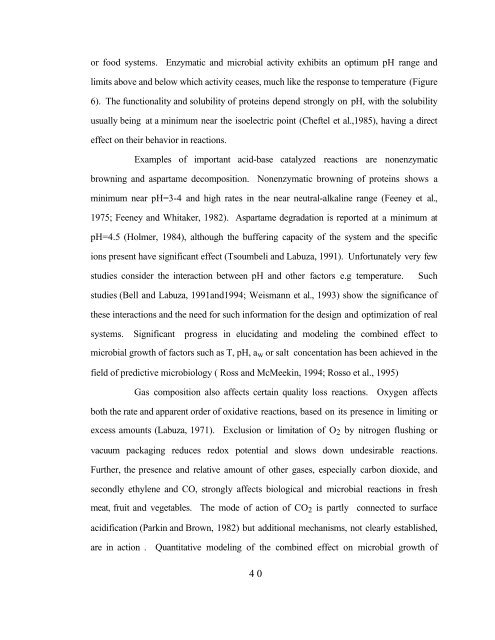the handbook of food engineering practice crc press chapter 10 ...
the handbook of food engineering practice crc press chapter 10 ...
the handbook of food engineering practice crc press chapter 10 ...
You also want an ePaper? Increase the reach of your titles
YUMPU automatically turns print PDFs into web optimized ePapers that Google loves.
or <strong>food</strong> systems. Enzymatic and microbial activity exhibits an optimum pH range and<br />
limits above and below which activity ceases, much like <strong>the</strong> response to temperature (Figure<br />
6). The functionality and solubility <strong>of</strong> proteins depend strongly on pH, with <strong>the</strong> solubility<br />
usually being at a minimum near <strong>the</strong> isoelectric point (Cheftel et al.,1985), having a direct<br />
effect on <strong>the</strong>ir behavior in reactions.<br />
Examples <strong>of</strong> important acid-base catalyzed reactions are nonenzymatic<br />
browning and aspartame decomposition. Nonenzymatic browning <strong>of</strong> proteins shows a<br />
minimum near pH=3-4 and high rates in <strong>the</strong> near neutral-alkaline range (Feeney et al.,<br />
1975; Feeney and Whitaker, 1982). Aspartame degradation is reported at a minimum at<br />
pH=4.5 (Holmer, 1984), although <strong>the</strong> buffering capacity <strong>of</strong> <strong>the</strong> system and <strong>the</strong> specific<br />
ions present have significant effect (Tsoumbeli and Labuza, 1991). Unfortunately very few<br />
studies consider <strong>the</strong> interaction between pH and o<strong>the</strong>r factors e.g temperature.<br />
Such<br />
studies (Bell and Labuza, 1991and1994; Weismann et al., 1993) show <strong>the</strong> significance <strong>of</strong><br />
<strong>the</strong>se interactions and <strong>the</strong> need for such information for <strong>the</strong> design and optimization <strong>of</strong> real<br />
systems. Significant progress in elucidating and modeling <strong>the</strong> combined effect to<br />
microbial growth <strong>of</strong> factors such as T, pH, a w or salt concentation has been achieved in <strong>the</strong><br />
field <strong>of</strong> predictive microbiology ( Ross and McMeekin, 1994; Rosso et al., 1995)<br />
Gas composition also affects certain quality loss reactions. Oxygen affects<br />
both <strong>the</strong> rate and apparent order <strong>of</strong> oxidative reactions, based on its presence in limiting or<br />
excess amounts (Labuza, 1971). Exclusion or limitation <strong>of</strong> O 2 by nitrogen flushing or<br />
vacuum packaging reduces redox potential and slows down undesirable reactions.<br />
Fur<strong>the</strong>r, <strong>the</strong> presence and relative amount <strong>of</strong> o<strong>the</strong>r gases, especially carbon dioxide, and<br />
secondly ethylene and CO, strongly affects biological and microbial reactions in fresh<br />
meat, fruit and vegetables. The mode <strong>of</strong> action <strong>of</strong> CO 2 is partly connected to surface<br />
acidification (Parkin and Brown, 1982) but additional mechanisms, not clearly established,<br />
are in action . Quantitative modeling <strong>of</strong> <strong>the</strong> combined effect on microbial growth <strong>of</strong><br />
40














